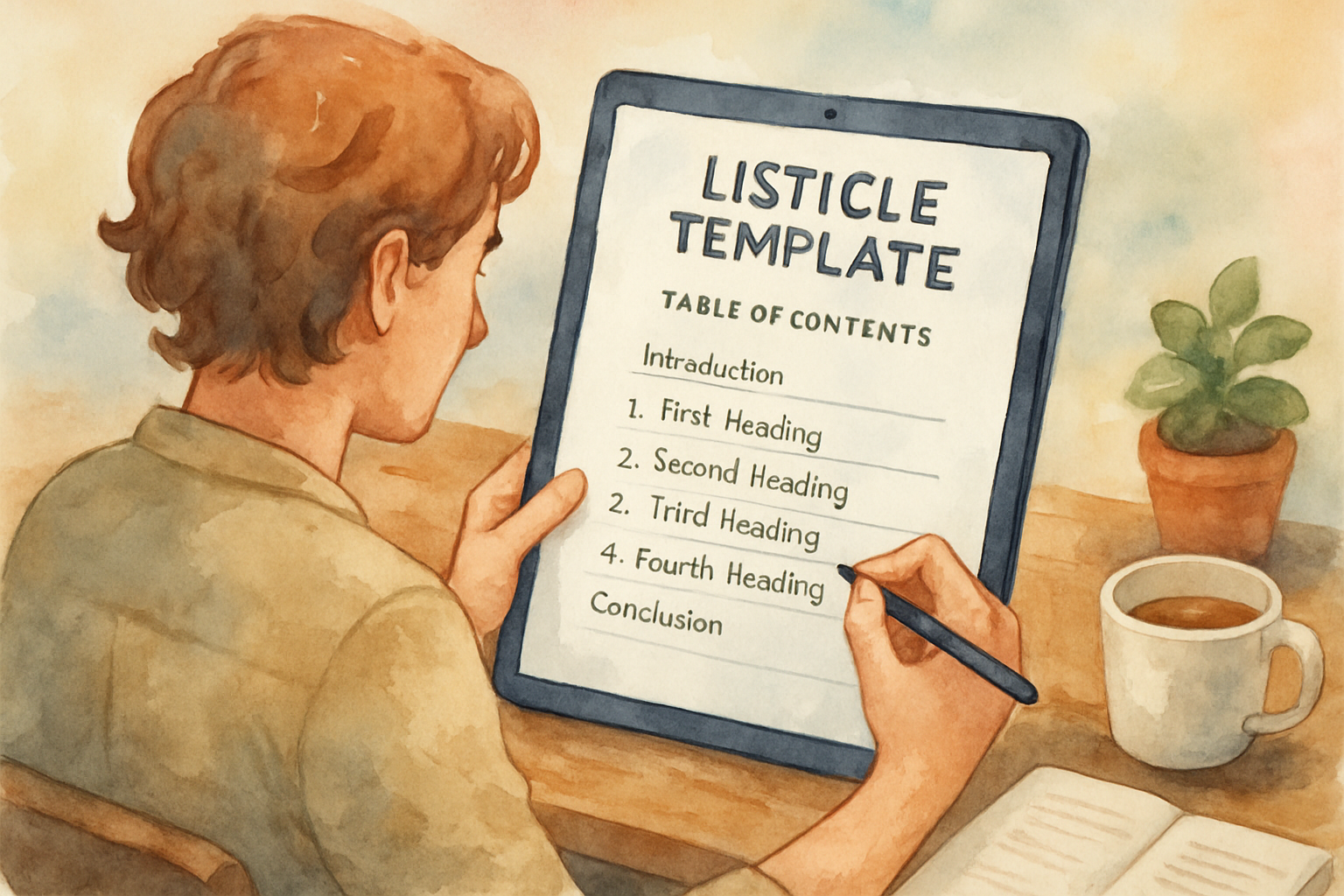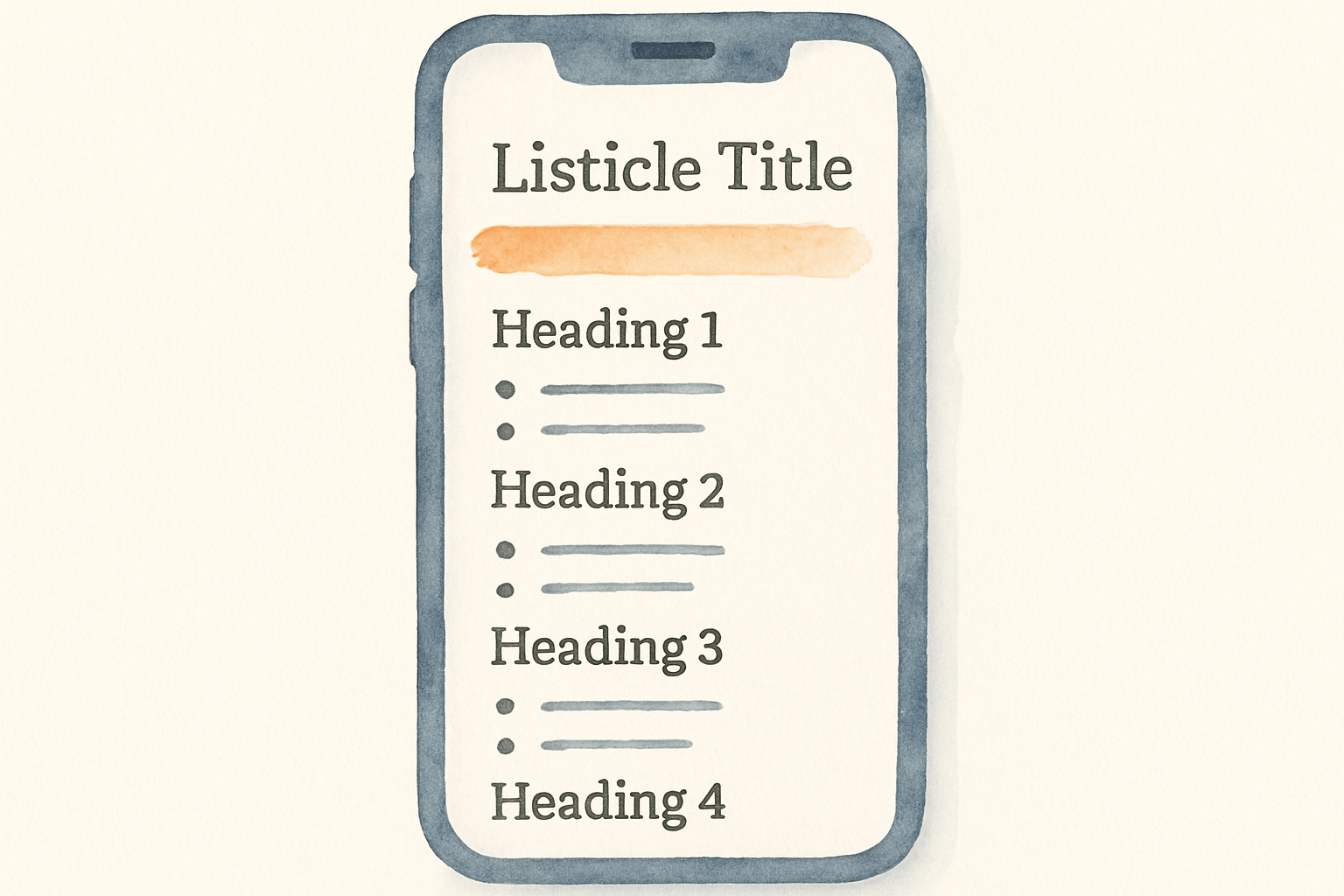Listicles are among the most beloved content formats online.
But what are they, exactly?
Here’s your comprehensive cheat sheet for creating the perfect listicle template.
Some are simple and punchy, delivering quick hits of valuable information.
Some are definitive, exhaustive guides that cover every key detail.
Some provide frameworks, walking readers step-by-step through complex processes.
Some combine detailed description with eye-catching visuals and interactive elements.
Some rank well in search engines and get shared widely on social media.
Let's dive right in.
What Is a Listicle Template? An Overview
A listicle template is a structured content framework that organizes information into a list format, combining the best parts of an article and a list.
Typically, each item on the list is numbered and accompanied by a brief explanation, insight, example, or tip.
This format is loved by readers because it makes content easy to scan. They immediately understand how much they're getting, and they can jump to sections that interest them most.
For content creators, listicle templates serve as efficient blueprints for producing organized, engaging, and SEO-friendly articles.
Whether you’re writing for entertainment, education, or marketing purposes, a clear listicle template can boost both speed and quality.
Listicles have evolved far beyond their early days as clickbait and memes, now appearing in serious government websites, news outlets, and comprehensive marketing strategies.Source

Why Listicles Work So Well for Readers and Marketers
Readers love listicles because of their predictability and digestibility.
Our brains crave organization and chunked information, making numbered lists easy to remember and share.
For busy readers or those with short attention spans, listicles present quick, actionable insights without unnecessary fluff.
Content creators favor listicles due to their flexibility:
- Scannability: Numbered headings break content into bite-sized chunks.
- Shareability: Readers love to share either whole lists or individual standout points.
- SEO Benefits: Listicles can target multiple long-tail keywords and rank well if structured properly.
- Engagement: They encourage user interaction through comments, shares, and click-throughs.
In fact, many top-performing SEO articles and viral content pieces are listicles.Source & Source
Types of Listicle Templates and When to Use Them
Understanding the main kinds of listicles helps you pick the perfect template for your content goals.
1. Simple Listicles
These are short, highly focused lists. Examples include “7 Tips for Better Sleep” or “10 Eco-Friendly Clothing Brands.” They are straightforward, easy to produce, and great for top-of-funnel content.
Simple listicles work well when you want to offer quick value without overwhelming detail.
2. Definitive (Expanded) Listicles
These are extensive, thorough articles covering every angle. Examples include “100 Must-Read Books” or “50 Ways to Improve Your SEO.” Definitive lists aim to be ultimate resources, often very long but structured for easy navigation.
This format is perfect when your topic is broad and multifaceted, or when you want to establish deep expertise.Source
3. Framework Listicles
Framework listicles guide readers through a process or methodology, such as “5 Steps to Build a Website” or a recipe listicle that breaks down a cooking method into distinct stages.
This format is excellent for instructional or educational content that needs clear progression.
**Want to craft a listicle that really captivates your readers?**Think carefully about which template fits your goals best before writing your headline or outline.
Crafting the Perfect Listicle Template: Step-by-Step
Here’s a detailed framework to follow when creating your listicle from scratch.
Step 1: Choose the Right Topic
Not every topic is suitable for a listicle. The best listicle topics are:
- Clearly divisible into distinct points or steps
- Specific enough to avoid vague “danglers” that don’t fit your list structure
- Relevant and valuable to your target audience
For example, “Best Gardening Tips for Spring” works better as a listicle than “Instagram Marketing,” which often requires a comprehensive guide instead.Source
Step 2: Craft Your Listicle Title
Your title needs to be concise, descriptive, and set the right expectations.
Use a number and keyword up front—for example, “10 Proven Listicle Templates to Boost Engagement.” Avoid clickbait that overpromises and underdelivers.
Good titles assure readers of exactly what value they will gain.
Step 3: Outline Your List Items Logically
Make each list point clear, actionable, and valuable.
Order your items to tell a story or follow a logical sequence: chronological steps, grouped categories, or strongest points first, middle, and last.
This improves flow and reader retention.
Step 4: Write Engaging Content for Each Item
Don’t just name the item—explain why it matters and how to implement or understand it.
Use examples, anecdotes, or statistics to deepen understanding.
Where applicable, add images, videos, or links to related resources to enrich the reader experience.
Step 5: Add a Table of Contents for Longer Listicles
If your list is extensive—think 10+ items—a navigable contents section at the top improves usability and SEO.
Readers can jump to sections that interest them quickly, improving engagement metrics.
Step 6: End with a Strong Conclusion and CTA
Wrap up the main takeaways and nudge readers on what to do next. This could be commenting, sharing, or exploring related resources.

Optimization Tips for SEO-Friendly Listicles
To rank well, your listicle template must incorporate SEO best practices.
- Incorporate Primary Keyword Early: Use “listicle template” naturally in the first 100-150 words, headers, and meta description.
- Use Descriptive Headings: Structure each list item with H2 or H3 headings containing relevant keywords.
- Optimize for User Intent: Understand the search intent behind your keywords and tailor the content accordingly.
- Include Internal Links: Boost SEO by linking to relevant pages within your own site, such as case studies or complementary blog posts.
- Leverage Multimedia: Embed images, videos, and charts to make content engaging and decrease bounce rates.
- Maintain Consistent Format: Be visually consistent with numbering, fonts, and bullet styles to avoid reader confusion.
Testing your listicle's performance continuously will give insights on what works best with your audience.Source
Listicle Landing Pages: Boosting Conversions Through Content
Listicles aren’t just for blogs—they also shine as landing pages, especially in ecommerce and marketing campaigns.
A listicle landing page blends educational content with strategic calls-to-action (CTAs) to gently guide prospects toward making a purchase or signing up.
Compared to traditional sales pages, listicle landing pages are shorter, easier to skim, and build trust before asking for conversions.
Leading brands like The Earthling Co. and Jones Road Beauty have used listicle landing pages with targeted benefits to specific audiences, resulting in higher engagement and sales.Source

How to Use AI to Simplify Listicle Writing
Creating comprehensive, SEO-optimized listicles can be time-consuming, but AI tools are changing the game.
Advanced AI-driven writing assistants help craft outlines, generate drafts, and optimize keyword usage to enhance Google rankings.
For instance, AI can help you:
- Generate catchy, keyword-rich titles.
- Create logical, detailed outlines with H2s and H3s to structure your listicle.
- Write clear, informative descriptions for each list item.
- Analyze competitor content to identify gaps and recommend topics to add.
- Optimize keyword density, meta descriptions, and headings for SEO.
With AI's assistance, marketers and writers can produce higher quality listicles faster, freeing them to focus on creativity and promotion.Watch this step-by-step AI listicle guide
Common Pitfalls to Avoid When Creating Listicles
Listicles are deceptively simple. If poorly done, they can frustrate readers and damage your brand.
Here are some traps to watch out for:
1. Too Much Fluff
Avoid filling your list with generic or obvious tips that offer no new value. Every item should give the reader actionable or surprising insights.
2. Mismatched or Irrelevant Items
Your list items should be consistent and focused on the topic. Don’t mix tips with unrelated examples or off-topic stories.
3. Neglecting Clear Formatting
Number each item clearly, use uniform headings, and break up text with images or bullet points to maintain reader interest.
4. Ignoring SEO Basics
Titles without numbers, unoptimized headings, or keyword stuffing can impair your listicle’s search rankings and user experience.
5. Forgetting User Navigation
In longer listicles, not providing a table of contents or anchor links forces readers to scroll endlessly, causing drop-offs.
By steering clear of these mistakes, you ensure your listicle maintains credibility and delivers real value.Source
Examples of High-Quality Listicles to Inspire You
Looking for inspiration? Here are some standout listicle examples that you can learn from and adapt.
BuzzFeed Book Lists
BuzzFeed’s book recommendation listicles combine simple design with useful information such as release dates and ordering links, making them highly shareable and actionable.
PerthNow Travel Lists
This travel list uses aspirational language and glossy photos, limiting the list to a top ten that entices readers without overwhelming them.
Nature’s COVID Inequality Graphics
An example of how listicles can tackle heavy topics by breaking complex data into concise, compelling visuals.
RELX Analytical Tools Listicles
These hybrid listicles blend practical advice with promotional content, successfully educating and converting leads.
Each of these follows the essential rules of clarity, actionable content, engaging design, and a strong focus on reader needs.Source
Best Practices for Using Your Listicle Template to Maximum Effect
To get the most from your listicle template:
- Know Your Audience: Tailor your list to their interests, needs, and language.
- Use Odd Numbers: Odd-numbered lists (7, 9, 15) can psychologically feel more complete and memorable.
- Be Concise: Avoid verbosity; keep paragraphs short and focused.
- Include Visuals: Photos, icons, illustrations, and videos increase scanability and time on page.
- Link Wisely: Add relevant internal links to drive readers to related content or services, like this ultimate SEO agency guide or this comparison article on website builders for deeper exploration.
- Optimize for Mobile: Ensure your listicle is easy to read on all devices.

Tools and Resources to Create Listicles Efficiently
Several tools can streamline listicle creation:
- AI Writing Assistants: Help generate outlines and content.
- Content Management Systems: Platforms like WordPress or Squarespace with built-in formatting support.
- SEO Research Tools: Tools such as Ahrefs or SEMRush identify keywords and analyze competitors.
- Template Services: Platforms offering pre-built listicle templates for quick use.
- Analytics: Google Analytics and similar to track listicle performance and optimize.
If you’re new to this, consider trying out the budget-friendly SEO tools for listicle research to get started affordably.
Conclusion: Harness the Power of a Listicle Template for Your Content Strategy
Listicles, when crafted well, are powerful hybrids of entertainment and education.
Using a thoughtfully designed listicle template lets you produce quality, SEO-optimized content that your audience will love and share.
Whether going for a simple list, a definitive guide, or a framework-based approach, the key is clear, valuable, and well-organized content.
Remember to avoid fluff, add visuals, and optimize for search engines and mobile devices.
With these tools and best practices, your listicles can become a cornerstone of your marketing, boosting traffic, engagement, and conversions.
What's Your Next Step?
Tell us in the comments: How will you apply this to your listicle template? For personalized advice, contact us!
(Verified with sources as of 2025-08-13)